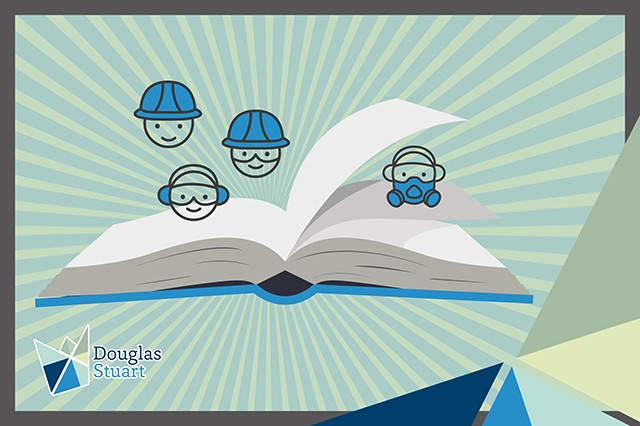Perhaps the ability to ‘storytell’ isn’t the first skill that springs to mind when you are hiring your safety team?
Technical competencies and relevant industry experience tend to be top of the job requirement list for senior safety professionals. And that’s not surprising. Organisations need to be compliant, manage risk effectively, reduce serious incidents and develop safety procedures. If you have complex and bureaucratic safety systems you need a robust and qualified expert to manage them.
But, it’s not enough.
Increasingly, discussions about what safety is, who ‘owns it’ and what that means for organisations and their employees, is influencing the skill profile required of safety professionals. Putting people at the centre of safety practice, and engaging them, from the bottom up, calls for creative communication skills. There are few more compelling ways to connect with your audience than the ability to tell stories, share, and sometimes, re-shape them. We need safety storytellers.
Why are stories important?
Whether we know it or not, we are all storytellers. Stories surround us; we live in a culture saturated with myths, films, novels, family history gossip and so on. We make sense of the world by telling stories, a way of ‘narrative knowing’ (Bruner 1990), that helps us structure, store and shape our experiences.
Stories tap into our emotions in the way that facts and statistics, no matter how compelling , cannot. A story can convey drama, pose dilemmas, present alternatives, and resolve conflict. We attend to stories because they speak to us directly and transport us through characters who are both recognisable and different. It is the act of making ‘the strange familiar and the familiar strange’ (Bruner), that cultivates in us, the sense of the possible.
What compelling ways can we use stories in safety?
Safety storytelling is a way of leveraging ‘lessons learned’ from personal experiences to draw out insight and context. Randy Cadieux, founder of V-Speed, LLC, who gives master classes in Storytelling says,
Bringing together the stories of both leaders and workers can be a powerful communication tool. It helps shorten the distance between front-line knowledge and leadership understanding. Or put another way, it bridges the gap between ‘work as planned’ and ‘work as done’.
This is a running theme in Todd Conklin’s’ Pre-accident podcasts – how the job of safety leaders is to, ‘ help the worker tell the story of how work happens in both success and unfortunately, failure.’ The gap between how work actually happens, and how it was originally planned, is often where the real insight into what’s going right, and what’s going wrong, lie. But those valuable stories don’t get heard if we don’t create an environment of trust where honest communication is possible.
All too often it’s the story of what should have happened that we hear. Closely followed by the story of ‘ what to fix’ – and then, naturally – who to blame. This approach is the enemy of learning and collaboration.
What we really need to share are the stories of what actually happened. And for that to happen we need to foster a positive safety culture. A culture where ‘blame’ is not an automatic adjunct to ‘failure’.
Stories as a tool for building trust.
We have to feel safe to tell our stories. Safety Leaders have a powerful impact on the degree of psychological safety experienced by their team, by setting an example through their own behaviour. Rosa Antonia Carrillo, Safety Leadership Consultant uses storytelling in Leadership workshops to breakdown trust and communication barriers. Rosa encourages attendees to share the highs and lows they have experienced in their ‘life story’. The act of revelation often fosters unexpected connectedness with other group participants. The personal risk that you expose yourself to by showing vulnerability has a significant correlation to the development of trust within a group. So much of the stories we share with other people are shaped by the need to preserve our sense of status and expertise. Being listened to without judgement can be both powerful and freeing, as Rosa comments,
‘There is so much pressure to present an image of infallibility that having the experience of being accepted just as they are is a unique experience.’
The use of ‘self-disclosure’ as a means to develop trust has other positive effects too. When we listen and share personal experiences we begin to break down our defensive mechanisms and engage emotionally. This is a far more effective way to drive change in attitudes and behaviour, than through increased rules and bureaucracy.
We attend to person centred stories because we understand, intuitively, that we too have to face difficult tasks and challenges. The most powerful learnings rarely come from facts or figures, however persuasive. We learn experientially, through ourselves and the vivid example of others.
How did it all go so right?
Often the emphasis on stories that we hear in health and safety tend towards ‘what went wrong’. Just flick through a newspaper and you will find stories about safety failings and their sometimes tragic consequences. And when it’s not stories about accidents and disasters, it’s stories about ‘Elf and Safety gone mad’ with mindless bureaucracy. The whole language surrounding safety is negative. This is, to coin a phrase from John Green, HSEQ Director of Laing O’Rourke, ‘unsafety’. Safety has become the absence of something – abscence of fatalities and of negative events.
There is a strong argument for reframing the language and discourse we have surrounding safety, as exemplified by the ‘safety differently’ approach used by Laing O’Rourke and other innovators. One of the core principles of ‘safety differently’ is that Safety is in fact, ‘the presence of positives’. What this means is that we address what went right 99% of the time, instead of focusing on what went wrong 1% of the time. Understanding past successes may give us a much better predictor of potential future success. We should be investigating, analysing and sharing stories about positive outcomes.
What are the characteristics of great storytellers?
You don’t have to be an extrovert to harness the power of storytelling. An understanding of how narrative works and the arc of a good story is something that can be studied and learnt. However, there are some skills and personal characteristics that Safety Leaders should consider developing to become better storytellers. The following are a few suggestions:
- Good storytellers are invariably good listeners – You need active listening skills to learn from your workers and their own stories. Data may give us facts, but it’s subjective experience that will often illuminate the contextual truth.
- Better questioning – The workplace is full of incomplete and partially told stories. To really understand what’s going on we need to first get to grips with ‘how’ work is happening. Often the ‘why’ becomes evident later.
- Courage – It’s a characteristic of truthful communication. It takes courage to share our own stories, to admit we don’t have all the answers, to have ‘real’ conversations with your team, and to empower your workers to have their own voice.
- Curiosity – Occasionally our own expertise can be a barrier to learning. We need to let go of assumptions and long held beliefs and be more childlike in our approach. Being curious allows us to step out of our comfort zone and opens the door to new ways of seeing, hearing and feeling.
- Commitment to collaboration – It’s important to identify who needs to hear the stories and how they are shared amongst peers, team members and management.
Injecting life into Safety
Increasingly, organisations are looking for Safety professionals who not only possess a high level of technical competency but who also demonstrate the traits of emotional intelligence and empathy. It’s in part a recognition of the fact that HSEQ teams are not ‘the safety police’, but whose role is to empower, coach and engage with all of the business operations. Safety is the province of every employee. Harnessing the power of stories engages the workforce from the ground up.
Emotionally engaging narratives inspire action and provide endless opportunities to evaluate, communicate and address collective insights.


